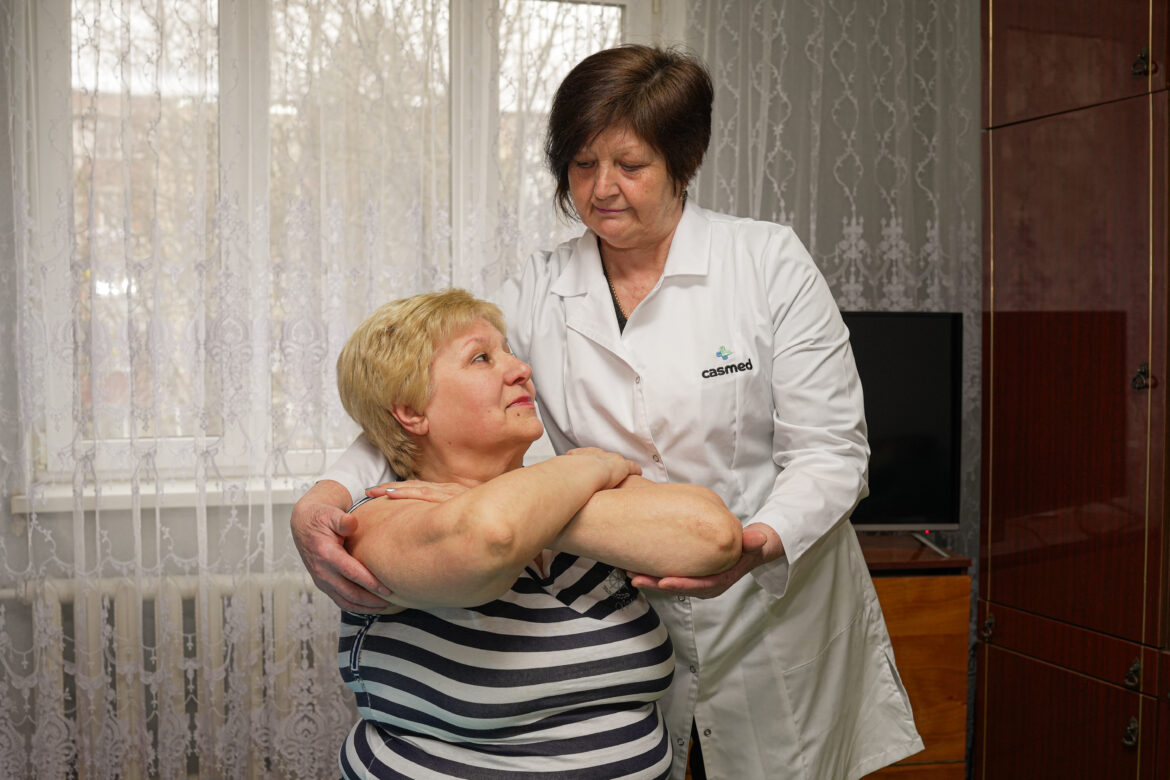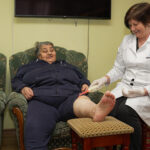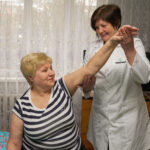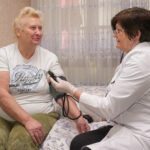
NURSING CARE SERVICES: A DAY WITH CASMED ‘S NURSE, ALEXANDRA CHIHAI
| 14.02.2025On the eve of Dragobete, we spent a day with Alexandra Chihai, a nurse at the “CASMED” NGO in Balti. She has been a member of the CASMED team since 2018 and cares for 15 people.
Mrs. Chihai can be found as early as 8 a.m. in the homes of those she cares for, where she diligently monitors their health and guides them on their path to recovery. Each beneficiary is unique, as are their health issues.
 Our first visit was to the home of Mrs. Liudmila Ș., one of our long-term beneficiaries. This 72-year-old woman has been receiving nursing services for 10 years, addressing conditions such as grade I-II osteochondrosis of the knee joints, diabetes mellitus, and obesity.The nurse begins her work by measuring Mrs. Liudmila’s blood pressure and blood sugar levels to ensure they are within normal ranges and prevent any risk of complications.
Our first visit was to the home of Mrs. Liudmila Ș., one of our long-term beneficiaries. This 72-year-old woman has been receiving nursing services for 10 years, addressing conditions such as grade I-II osteochondrosis of the knee joints, diabetes mellitus, and obesity.The nurse begins her work by measuring Mrs. Liudmila’s blood pressure and blood sugar levels to ensure they are within normal ranges and prevent any risk of complications.
She then administers treatment using an electrotherapy device called a Darsonval. Darsonvalization is a medical procedure that uses high-frequency currents to improve blood circulation, reduce inflammation, and relieve pain. The nurse applies the Darsonval device’s electrode to the affected area of Mrs. Liudmila’s leg for several minutes. Mrs. Liudmila feels slight tingling and warmth but experiences no pain.
Mrs. Chihai’s regular visits and dedicated work have significantly contributed to improving Mrs. Liudmila’s health. Mrs. Liudmila deeply appreciates the nurse’s efforts and is grateful for her care and devotion. She considers herself a member of the family and eagerly awaits her visits.
 After completing this visit, we proceed to the next apartment. Here resides Mrs. Afanasia G., 67 years old. She suffers from the after-effects of a right-sided ischemic stroke with mild left-sided hemiparesis. Simply put, this refers to the residual lesions or impairments that can remain after an ischemic stroke.
After completing this visit, we proceed to the next apartment. Here resides Mrs. Afanasia G., 67 years old. She suffers from the after-effects of a right-sided ischemic stroke with mild left-sided hemiparesis. Simply put, this refers to the residual lesions or impairments that can remain after an ischemic stroke.
For Mrs. Chihai, any method that can support the beneficiary is researched and implemented. One technique she has embraced and uses as a rehabilitation method with Mrs. Afanasia is Kinaesthetics. This involves a set of exercises that the nurse and patient perform together. Special attention is given to the affected or less mobile body parts. Even a gentle touch and a small impulse are enough to stimulate the body to function, and to remember movements it performed automatically in the past. Through Kinaesthetics, the nurse helps beneficiaries discover new possibilities of movement that lead to the reduction of back pain, muscle tension, and other similar problems caused by everyday activities.
Mrs. Afanasia is delighted with the progress she has made since she began practicing Kinaesthetics with the nurse. She feels stronger, more independent, and better able to manage daily activities on her own.
“At first, it was very difficult for me to move, dress, or do housework,” Mrs. Afanasia tells us. “Now, thanks to Mrs. Chihai’s help, I can do many things that I couldn’t do before. I am very grateful for everything she does for me.”
 The last scheduled visit is to Mrs. Alla N., 71 years old. She suffers from cervical osteochondrosis and grade III gonarthrosis in both knees. After measuring her blood pressure, Mrs. Chihai proceeds to gently massage her legs using a moisturizing cream. With delicate yet firm movements, she massages each leg individually, from toes to knees, focusing on the areas where Mrs. Alla feels pain.
The last scheduled visit is to Mrs. Alla N., 71 years old. She suffers from cervical osteochondrosis and grade III gonarthrosis in both knees. After measuring her blood pressure, Mrs. Chihai proceeds to gently massage her legs using a moisturizing cream. With delicate yet firm movements, she massages each leg individually, from toes to knees, focusing on the areas where Mrs. Alla feels pain.
“After each session, I feel much lighter and more relaxed. The leg pain subsides, and I can sleep better at night,” Mrs. Alla says.
In the end, we are left with a feeling of fulfillment. Beyond the medical procedures, whether measuring blood pressure, physiotherapy, or Kinaesthetics — we saw gratitude and a spark of hope in the patient’s eyes. Mrs. Chihai not only treats; she listens, encourages, and offers a warm smile. She is more than a nurse; she is a precious source of human support for those in need.
The Public Association “CASMED” is a non-governmental, independent, and non-profit organization registered in December 2010. Its mission is to support elderly and disadvantaged individuals by developing and implementing social, educational, and health projects. Home medical care services are one of the Association’s core activities. These services are designed to support elderly individuals and people with disabilities, helping them maintain functional autonomy as much as possible so they can continue living in their own homes with dignity and respect. The medical services focus on the prevention and treatment of conditions caused by diabetes mellitus, hypertension, pressure sores, stroke, osteoarthritis, and other diseases commonly affecting the elderly.


 Română
Română Русский
Русский

